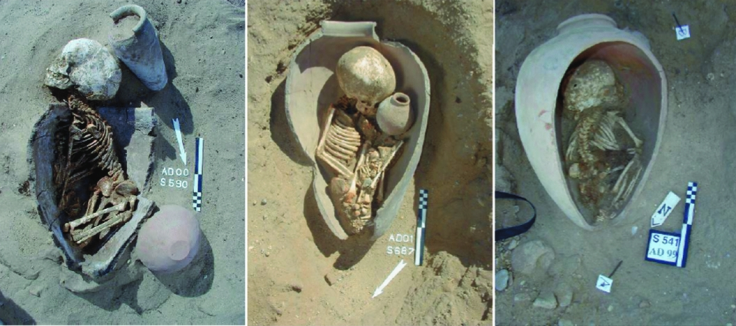Mysterious Ancient Egypt 'pot burials' stand as metaphor for rebirth in the afterlife
The pots may have been seen as a symbols of the womb in which to bury the deceased – adults and infants.
Ancient Egyptians may have become famous for the beautiful and complex tombs they built for their kings at the heart of pyramids, but they also buried their dead in ceramic vessels – a practice known as "pot burial".
This constitutes one of the most widespread funerary practices across the cultures and regions of the ancient world, but there is still a lot of debate regarding why it came about and what its purpose was. Scholars also disagree about what its meaning in the context of Ancient Egyptian culture was.
In such burials, people reused small domestic vessels. For this reason, pot burials have been taken to indicate low value and have long been associated with poverty by archaeologists. These burials are also regarded as the most frequent form of interment for children, infants and fetuses in ancient Egypt, second only to direct interment into the earth.
Now, a study recently published in the journal Antiquity challenges these theories. The two authors, Ronika Power and Yann Tristant from Macquarie University in Sydney, reviewed published data about pot burials at 46 sites in Egypt, near the Nile River. All were dated from about 3300BC to 1650BC. Their findings suggest that pot burials may have had a more complex and symbolic value within Ancient Egyptian culture than is often portrayed.

Fertility symbolism
Some of the evidence reviewed in the study contradict the view that pot burials were linked to poverty. Some of these burials in fact appear to have been very richly furnished. This is the case of a pot burial found alongside ancient Governor Ima-Pepi, in his tomb dating back to the Old Kingdom / early First Intermediate Period. It contains the remains of a baby and comes with an array of sophisticated grave goods including beads covered in gold foil.
"When we compiled the evidence for the various modes of burial within our sample, it became clear that although pot burials had previously been considered as the preserve of the poor, they had actually been furnished for the afterlife in a very similar way to other modes of burial in terms of their grave goods and afterlife provisions", study author Dr Ronika K. Power, lecturer in bioarchaeology at Macquarie University, told IBTimes UK.
"This was clear from the number of grave goods observed in many pot burials, as well as the nature of the materials used to create the grave goods, including gold, ivory, ostrich eggshell, textiles or ceramics. The baby pot burial mentioned in our paper is an excellent example to illustrate that pot burials may have been chosen for reasons other than resource limitations of bereaved family or community members - our research argues that pot burials may have been chosen because they had important symbolic value, too".
The researchers also question the hypothesis that pot burials were often used for babies and fetuses. Some of the pots actually contain the remains of adults. Furthermore, of the 1809 child and foetal remains found at the sites described in the study, only 329 young individuals had been buried ceramic pots. For deceased babies, burials in the ground was in fact much more common.
However, as Power mentions, the most interesting finding is perhaps that the pots may not have been seen as old objects that needed to be reused, but as containers with a highly symbolic value.
In many ancient cultures, from Europe to North Africa, pot burials were associated with a strong fertility symbolism. The ceramic pots stood as a symbol of the uterus. Burying the corpse in them was intended as a return to the womb in death, to promote metaphorical rebirth in the afterlife.

Analysing hieroglyphic texts found in an ancient Egyptian tomb chapel, the researchers suggest that this interpretation could also apply to Egyptian pot burials, as the writings bear evidence that Egytpians also saw the pots as symbols of the womb and fertility.
"The ceramic containers may have reflected symbolic associations between pots, wombs and eggs, facilitating rebirth and transition into the afterlife", the authors say. This means that pot burials were not necessarily a sign that people didn't have the resources to bury their loved-ones. Rather, their funeral might have had a special symbolic importance.
"Pots were deliberately selected and reused as funerary containers for what may have been a variety of pragmatic and symbolic reasons", the authors conclude.
© Copyright IBTimes 2025. All rights reserved.






















